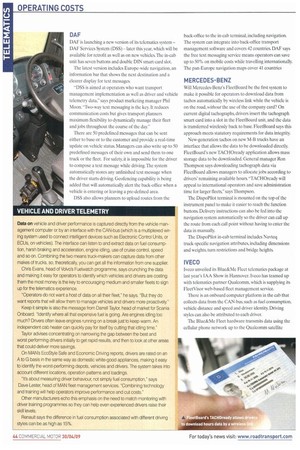VEHICLE AND DRIVER TELEMETRY
Page 44

If you've noticed an error in this article please click here to report it so we can fix it.
Data on vehicle and driver performance is captured directly from the vehicle management computer or by an interface with the CAN-bus (which is a multiplexed wiring system used to connect intelligent devices such as Electronic Control Units, or ECUs, on vehicles). The interface can listen to and extract data on fuel consumption, harsh braking and acceleration, engine idling, use of cruise control, speed and so on. Combining the two means truck-makers can capture data from other makes of trucks, so, theoretically, you can get all the information from one supplier.
Chris Evans, head of Volvo's Fuelwatch programme, says crunching the data and making it easy for operators to identify which vehicles and drivers are costing them the most money is the key to encouraging medium and smaller fleets to sign up for the telematics experience.
"Operators do not want a host of data on all their fleet," he says. "But they do want reports that will allow them to manage vehicles and drivers more proactively," Keep it simple is also the message from Darrell Taylor, head of market for Scania Onboard. 'Identify where all that expensive fuel is going. Are engines idling too much? Drivers often leave engines running on a break just to keep warm. An independent cab heater can quickly pay for itself by cutting that idling time."
Taylor advises concentrating on narrowing the gap between the best and worst performing drivers initially to get rapid results, and then to look at other areas that could deliver more savings.
On MAN's EcoStye Safe and Economic Driving reports, drivers are rated on an A to G basis in the same way as domestic white-good appliances, making it easy to identify the worst-performing depots, vehicles and drivers. The system takes into account different locations, operation patterns and loadings.
"it's about measuring driver behaviour, not simply fuel consumption," says Dave Lester, head of MAN fleet management services. "Combining technology and training will help operators improve performance and cut costs."
Other manufacturers echo this emphasis on the need to match monitoring with driver training programmes so they can help even experienced drivers raise their skill levels.
Renault says the difference in fuel consumption associated with different driving styles can be as high as 15%,












































































































































